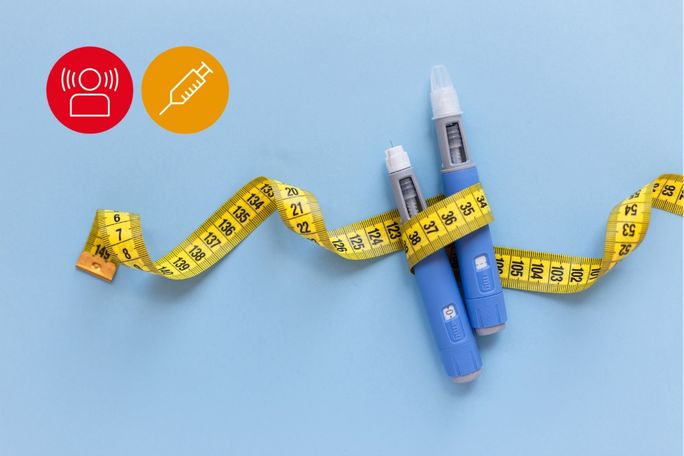
As part of an ongoing, multi-pronged and tech-assisted approach to tackling ads for weight-loss prescription-only medicines (POMs), we have taken action against nine advertisers who, against the law and our rules, have been promoting these drugs to the public. Using our AI-based Active Ad Monitoring system to monitor for problem ads and launch proactive investigations, we have published rulings that make crystal clear that all injectable forms of weight-loss medication are POMs and can’t be advertised, even where ads don’t explicitly name a medicine.
This work is shaped, in part, by what’s happening more broadly in society.
A high-profile issue
Turn on the TV, read a newspaper, browse social media; chances are you’ll have seen or heard about weight-loss POMs. In a short space of time, they have become part of a national conversation. They are a central plank in government’s health plans to tackle obesity. Public awareness and interest in these drugs is high.
We’re not here to regulate the drugs, their safety or availability. And we acknowledge the role they might play in combatting obesity. But we are here to protect people from irresponsible and, in the case of weight-loss POMs, illegal ads.
The law prohibits POMs from being advertised to the public for good reason. These are powerful drugs which can only be prescribed after consultation with a medical professional and require appropriate medical supervision. They are not a cosmetic treatment to be used without serious consideration and advertisers should not be promoting them to the public. That’s why in December we issued a warning to businesses and individuals targeting the public with ads for these medicines. And we set out our commitment to an extensive rolling programme of monitoring, investigation, enforcement action and partnership working.
Problem ads
Our rulings form a key part of this work. They set clear precedents for advertisers, predominantly pharmacies, that not only is advertising named weight-loss drugs (Wegovy, Mounjaro, Ozempic, Saxenda among others) banned, the use of various claims and images that indirectly advertise these medicines is also prohibited.
Claims including “Weight Loss Injections”, “Weight Loss Pen”, “Obesity Treatment Jab" and “GLP-1” are references to weight-loss POMs and aren’t allowed. Abbreviating the name of a weight-loss POM is also a problem.
And our rulings go even further; they establish that, in the context of an ad for a weight-loss POM treatment, even when the medicines are not explicitly featured in an ad, using certain imagery will also break the rules. That means unbranded medical injection pens, partial images of an advertiser branded medical injection pen and images of a vials of liquid on the front, cannot be featured in ads.
Tech-assisted and proactive action
Harnessing our Active Ad Monitoring system (AAM), our investigations and rulings sit alongside extensive monitoring and enforcement work that we’ve been carrying out since we launched this project. It has enabled us to check ads at pace and scale, identify problems, provide intelligence to our Compliance and Investigations teams and take action as needed. This has included:
- Monitoring weight-loss POM ads from 35 high priority pharmacies (those who had been the subject of a complaint to the ASA since December 2024 or been identified as potentially problematic by our AAM system industry sweeps)
- Capturing over 20,000 ads from these pharmacies (Feb to June 2025), 10,000 of which were for weight-loss treatments
- Of those, 80 ads were found to directly use or mention a named weight-loss drug name. This points to over a 99% compliance rate for this strict element of the rules
- Identifying that most of those ads did not reference a named weight-loss POM but instead used imagery of weight-loss pens, or strongly implied the use of weight-loss POMs without naming the drug (something which our rulings address)
Partnership working
In all of this, we continue to work closely with our partners, the Medicines and Healthcare products Regulatory Agency (MHRA) and General Pharmaceutical Council (GPhC). We issued a joint Enforcement Notice to all 13,214 pharmacies registered with the GPhC, putting pharmacies on notice of our action in this area and which has led to improved compliance rates in paid-ad space. We’ve taken an education first approach and proactively contacted advertisers not sticking to the rules and given them the tools to comply. And we put on a joint training webinar with GPhC and MHRA for pharmacies, attended by 480 delegates, on how the rules apply and the help and guidance that’s in place.
This remains a high-priority area and one where we’re taking a joined-up approach to collectively tackle this issue.
Further action
We are encouraged to see an improvement in advertisers sticking to the rules in some areas, but there’s more to do and we’re lining up further action. We have further investigations underway and rulings to come, a bulk of which involve affiliate advertisers. While the majority of pharmacy ads not naming weight-loss drugs in their ads is a positive story, indirect references (images of injection pens, references to GLP-1 treatments) are an ongoing concern.
Our main focus has been on the paid- for ad space, an area where we believe our work will have the most impact. We are also monitoring weight-loss POM ads in other channels including organic content, adding to our intelligence and taking action as needed. And following our rulings, we will be conducting ongoing monitoring sweeps using our Active Ad Monitoring system to check advertisers are sticking to the rules and taking swift action where they’re not. We’ll also be undertaking future sweeps to ensure we have early sight of any other issues which require action.
These issues won’t be resolved overnight, we know the scale of the problem and that means approaching this in a methodical, phased way. We’ll continue to make sure weight-loss providers take their medicine rather than advertising it.
More on
-
Keep up to date
Sign up to our rulings, newsletters and emargoed access for Press. Subscribe now.


